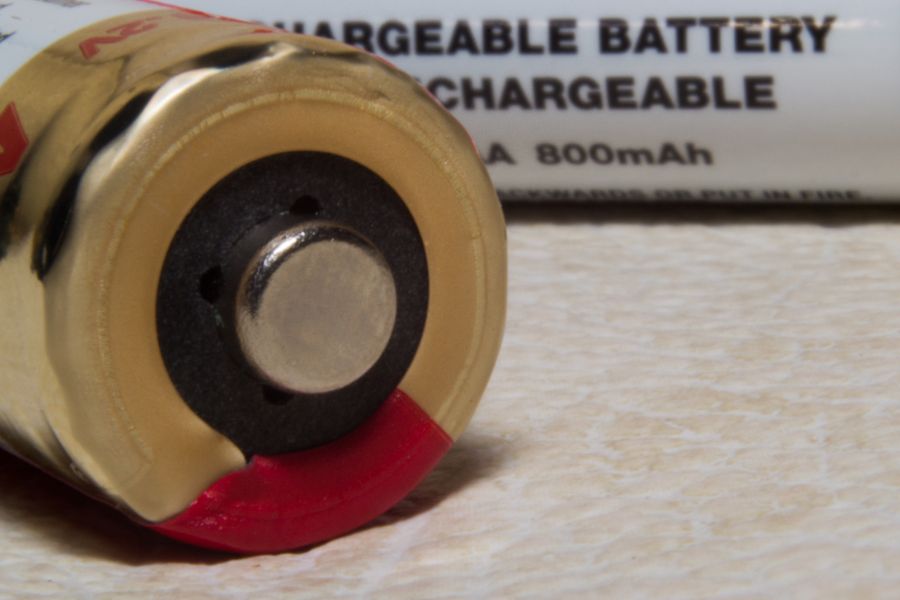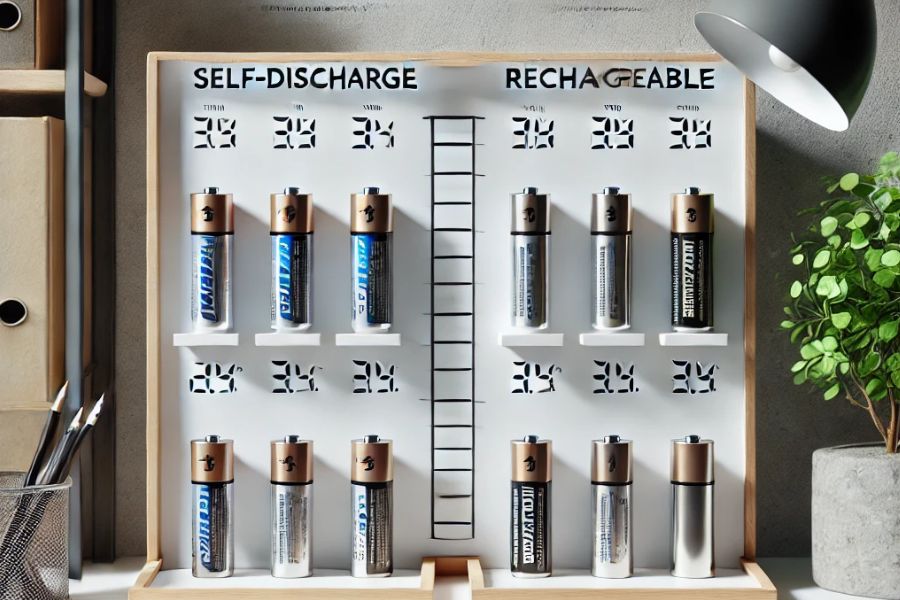Alkaline Vs. Rechargeable Batteries for Small Electronics
For small electronics, choosing between alkaline and rechargeable batteries depends on your device needs and usage. Alkaline batteries, readily available and affordable, work best for low-drain devices like remotes, offering stable performance and a long shelf life.
However, they are single-use, contributing to electronic waste. Conversely, rechargeable batteries can be reused multiple times, providing consistent power for high-drain devices, reducing waste and offering long-term cost-effectiveness.
Despite their higher initial cost and need for regular recharging, they’re usually more economical in the long run. There’s more to discuss about these battery types including cost-effectiveness and environmental impact, so stick around to learn more.
Pros and Cons of Alkaline Batteries in Small Electronics
In numerous small electronics, we often find ourselves reaching for alkaline batteries due to their accessibility and affordability. The debate of alkaline vs. rechargeable batteries brings us to reflect on the pros and cons of alkaline batteries in small electronics.
On the plus side, alkaline batteries hold an edge regarding immediate availability and cost-effectiveness. They’re easy to find in any store, and you don’t need to worry about charging before use. This makes them a convenient choice for devices like remote controls and toys.
However, it’s essential to evaluate the alkaline battery lifespan. While they’re handy in a pinch, their endurance is finite. They can’t be recharged, meaning once they’re drained, they’re destined for the waste bin. This not only leads to more frequent replacements but also contributes to electronic waste.
Safety-wise, alkaline batteries are generally safe if used correctly. They offer stable performance and don’t require special handling. But remember, improper disposal can lead to environmental harm.
In essence, while alkaline batteries have their benefits, they also come with drawbacks. Your choice between alkaline and rechargeable batteries should hinge on your specific needs and concerns.
Benefits of Rechargeable Batteries for Gadgets

Shifting gears, let’s explore the many benefits of rechargeable batteries for our favorite gadgets. When it comes to finding the best batteries for small electronics, rechargeables are a top contender. They’re reliable, efficient, and offer a significant cost benefit in the long run.
One of the key advantages of rechargeable batteries is their performance. Unlike their disposable counterparts, rechargeable batteries can be used repeatedly. This results in less waste and means you’re not constantly buying replacements. In fact, some rechargeable batteries can be reused hundreds of times before they need replacing, providing significant cost benefits.
Safety is another area where rechargeable batteries shine. Many models have built-in safety features to prevent overcharging and overheating, which can lead to longer device life. Plus, the risk of leakage is lower compared to alkaline batteries.
Particularly for power-hungry gadgets, rechargeable batteries offer more consistent performance. They maintain a steady voltage output, ensuring your devices run at their best for longer.
In short, rechargeable batteries are not only a cost-effective choice for small electronics, but they also offer superior performance and safety benefits. So, next time you’re shopping for batteries, consider the advantages of going rechargeable.
Comparing Alkaline and Rechargeable Battery Lifespan
Although rechargeable batteries offer a myriad of advantages, we can’t overlook the importance of battery lifespan when evaluating our options. In comparing battery life: alkaline vs. rechargeable, we have to assess various factors. Alkaline batteries are known for their long shelf life and can power a device for a longer period in a single use. They are generally more reliable for equipment that is infrequently used.
Rechargeable batteries, on the other hand, have a shorter lifespan per charge but can be recharged and reused multiple times. But beware, rechargeable batteries have higher battery self-discharge rates. This means they lose their charge over time, even when not in use.
When it comes to long-lasting batteries for electronics, the choice is not straightforward. If you’re looking for a one-time-use, long-lasting battery, alkaline may be your best bet. But if you use your device frequently and can manage regular recharging, rechargeable batteries could be a more sustainable choice.
Which Battery Type is Cost-Effective?
Our wallets often have the final say when it comes to choosing between alkaline and rechargeable batteries. But which option is truly more cost-effective? Let’s break it down.
Alkaline batteries have a lower upfront cost, making them an attractive choice when purchasing batteries for gadgets. However, they are single-use, which means you’ll be buying replacements more frequently. Over time, those costs can add up.
On the other hand, rechargeable batteries have a higher initial cost, but they can be recharged and used again and again. This means that in the long run, you could actually save money. Of course, the actual savings will depend on how often you use your device and how quickly it drains the battery.
Now, it’s also important to weigh the environmental impact of alkaline batteries. They are not as easily recycled as rechargeable batteries, and improper disposal can lead to environmental harm. So even though you might save a few dollars upfront, the true cost may be higher than you think.
Environmental Impact of Alkaline vs. Rechargeable
Building on our cost analysis, let’s consider the environmental implications of using alkaline versus rechargeable batteries. We’re all aware of our responsibility to reduce waste and promote recycling, and our choice of batteries can greatly impact that goal.
Alkaline batteries are single-use. Once depleted, they often end up in landfills, contributing to waste. Some states consider them hazardous waste due to the metals they contain, posing potential risks to soil and water.
Contrarily, rechargeable batteries, such as nickel-metal-hydride (NiMH), can be recharged hundreds of times before they lose their effectiveness. This considerably reduces the amount of batteries ending up in landfills. Plus, many rechargeable batteries are recyclable, further minimizing their environmental footprint.
However, the manufacturing process for rechargeable batteries can be more energy-intensive and produce more greenhouse gases than for alkaline batteries. It’s a balancing act.
So, are we trading one environmental problem for another? Not exactly. Though the initial manufacturing impact is higher for rechargeables, their extended lifespan and recyclability make them the greener choice overall.
We should remember, safety is paramount. Both battery types should be disposed of properly to guarantee our safety and protect the environment.
Battery Performance in Small Electronics

Switching gears to our next topic, let’s explore the performance of alkaline and rechargeable batteries in small electronics. Both have their strengths, but understanding their differences can help us make safe and effective choices for our devices.
Alkaline batteries are known for their impressive shelf life, making them ideal for low-drain devices like clocks or remote controls. They’re ready to use straight off the shelf, providing consistent power until they’re completely depleted. However, their one-time use means you’ll be replacing them more often, which can be inconvenient.
Rechargeable batteries, on the other hand, have a lower initial voltage but maintain their power level longer. They’re perfect for high-drain devices like digital cameras or handheld gaming consoles. The real advantage comes with their ability to be recharged hundreds of times, saving you money in the long run. They do require an initial investment in a charger, and remembering to recharge them is essential.
Safety-wise, both types are reliable if used correctly. Always remember to match the battery type to your device’s requirements. Misuse can lead to overheating or leakage, which is a hazard we all want to avoid.
Stay tuned for our next segment, where we’ll investigate even deeper into battery choices for specific devices.
Choosing the Right Battery for Remote Controls
When it comes to remote controls, choosing the right battery can make all the difference. Both alkaline and rechargeable batteries have their merits, but understanding your device’s needs is paramount.
For most remotes, a standard alkaline battery is the smart choice. They’re cost-effective, readily available, and safe. They offer a stable power output, ensuring your remote works consistently until the battery is depleted. You don’t have to worry about any complex charging mechanisms or monitoring battery health.
However, if you’re someone who uses a remote heavily, or if you have a high-drain device, rechargeable batteries might be more cost-effective in the long run. They can be recharged hundreds of times before they need replacing, reducing waste and saving money. Plus, their performance isn’t heavily affected by cold temperatures, making them suitable for outdoor devices.
When to Use Alkaline Batteries for Electronics
Let’s dive right into the topic of when it’s best to use alkaline batteries for electronics. Alkaline batteries are perfect for devices that need a steady, reliable source of power. Think about those small electronics we use daily, like remote controls, flashlights, or wall clocks. They don’t consume a lot of power, but when they need it, they need it consistently.
One of the key advantages of alkaline batteries is their excellent shelf life. You can store them for years, and they’ll still have plenty of juice when you need them. That’s why they’re a good choice for emergency kits. You can count on them to power your safety equipment when it matters most.
But remember, alkaline batteries aren’t rechargeable. Once they’re out of energy, you need to dispose of them properly. They’re not ideal for electronics that drain energy quickly or are used intensively, like digital cameras or gaming controllers.
Common Uses for Rechargeable Batteries
Often, we find ourselves reaching for rechargeable batteries, especially when it comes to our high-usage electronics. Portable devices, like cameras, gaming consoles, and remote-controlled toys, are just a few examples where rechargeable batteries shine. They provide the longevity and reliability we need for those marathon gaming sessions or hours-long photo shoots.
Rechargeables are also ideal for our everyday, power-hungry devices. Think about our smartphones, tablets, and laptops – they all depend on rechargeable batteries. Without them, we’d be constantly buying and discarding single-use batteries, which isn’t great for our wallets or the environment.
We also can’t forget about our safety devices. Smoke detectors, carbon monoxide alarms, and emergency flashlights are all critical to our well-being. These devices often sit unused for long periods, but when they’re needed, they need to work. That’s another area where rechargeable batteries come in handy, offering dependability in our times of need.
Comparing Self-Discharge in Alkaline and Rechargeables

In our quest to understand batteries better, we need to contemplate the phenomenon of self-discharge. This is when a battery loses power over time, even when not in use. It’s like a leaky bucket, slowly draining away.
Let’s compare how alkaline and rechargeable batteries fare in this regard. Alkaline batteries have a slow self-discharge rate, which means they can sit on your shelf for years without losing much power. They’re a reliable choice for devices you don’t use often.
Rechargeable batteries, however, have a higher self-discharge rate. They can lose a significant amount of their charge within a few weeks of sitting idle. You might think, “That’s not great”, but don’t rule them out yet.
One advantage rechargeable batteries have is, well, they’re rechargeable. They can be topped up any time, and repeatedly so. This makes them ideal for devices you use frequently. Remember, safety is paramount. Always follow the manufacturer’s instructions when charging to prevent any risk of overheating.
Battery Recommendations for Popular Gadgets
Choosing the right battery for your gadgets can be quite a puzzle. But don’t worry, we’re here to help guide you through.
For high-drain devices like digital cameras, we recommend rechargeable batteries, specifically Nickel-Metal Hydride (NiMH) ones. They can handle the high power demand, and they’re more cost-effective in the long run. Plus, they’re eco-friendly – a win for you and the planet!
On the other hand, alkaline batteries are a solid choice for low-drain devices like remote controls, clocks, and flashlights. They’re less expensive upfront and have a longer shelf-life, which means they won’t let you down when you need them most.
Safety is paramount, so no matter what battery type you choose, make sure to use them correctly. Always match the battery to the device’s required size and voltage, and replace all batteries at the same time to prevent leakage or damage.
Future Trends in Batteries for Small Devices
We’re on the cusp of some exciting advancements in the world of batteries for small devices. The future is bright and full of safer, more efficient energy solutions. In this ever-evolving technological era, battery developers are focusing their efforts on three key areas:
- Safety Improvements: Lithium-ion batteries have dominated the market for years, but their occasional safety issues have pushed scientists to explore safer alternatives. Solid-state batteries are one such option, promising high energy density without the fire hazards.
- Longer Lifespan: The longevity of a battery life is a vital consideration for any device. Developers are aiming to design batteries that can last longer between charges and have a longer overall lifespan. This will reduce waste and make our devices more efficient.
- Sustainability: There’s a growing emphasis on creating batteries from eco-friendly materials. This trend is poised to become a game-changer, reducing our carbon footprint and making our tech habits more sustainable.
In short, the future of batteries for small devices is shaping up to be safer, more efficient, and more sustainable. We’re looking forward to seeing these developments become a reality.
Conclusion
To sum up, we’ve seen that both alkaline and rechargeable batteries have their strengths and weaknesses. Alkaline batteries offer convenience, while rechargeables are cost-effective and eco-friendly. The choice will largely depend on your specific needs and device usage.
As technology evolves, we expect to see exciting advancements in battery tech. Stay tuned, and we’ll keep you updated on the latest trends to help you make the best choice for your small electronics.

